|
|
Post by Dietmar on Nov 18, 2008 10:03:11 GMT -5
We discussed Iron Shell and his family in several other threads. Here he is in 1872, when Alexander Gardner photographed him in Washington: 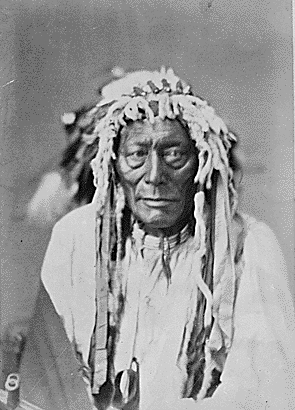  (from SIRIS)  (from SIRIS) 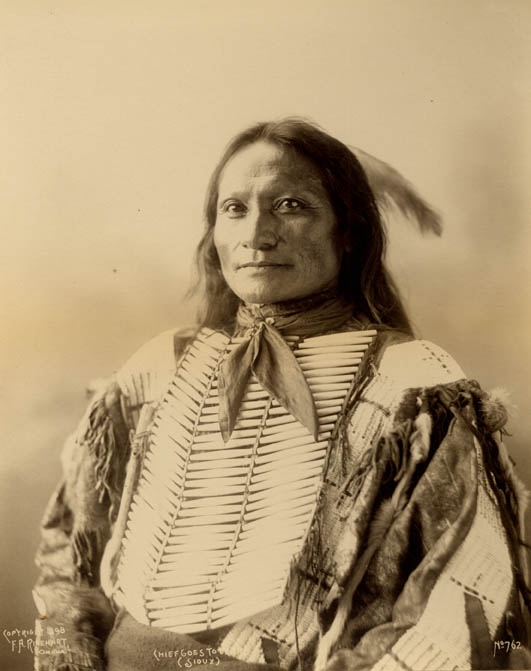 Goes To War, son of Iron Shell 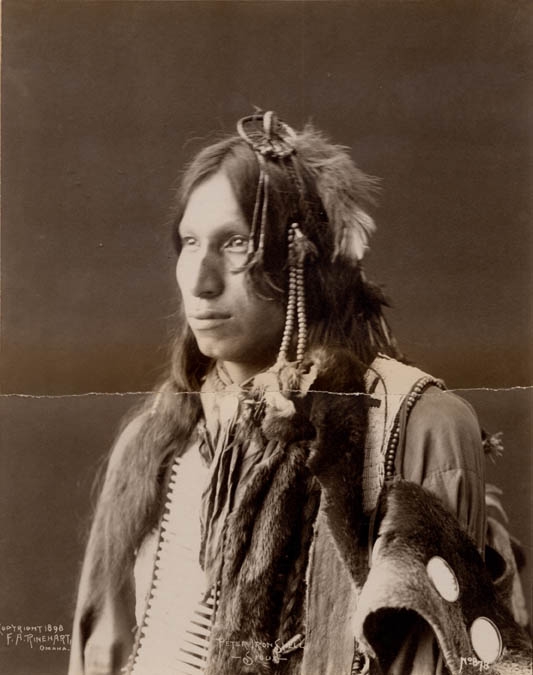 Peter Iron Shell, son of Iron Shell 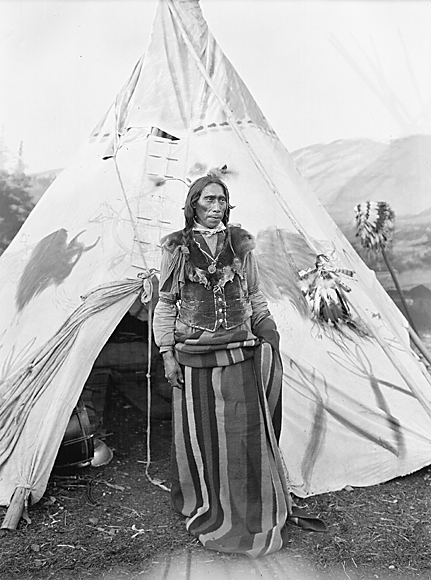 Peter Iron Shell 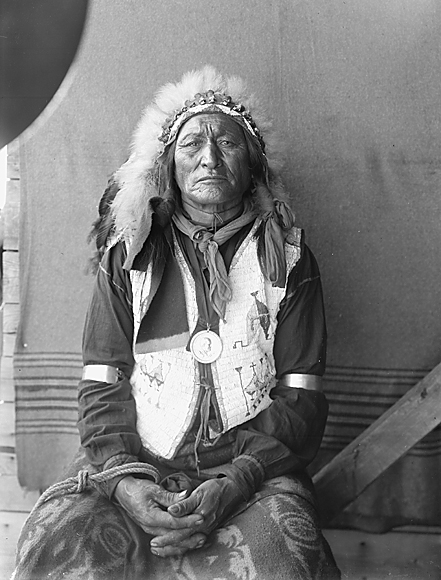 Another Iron Shell, who toured with Pawnee Bill´s Wild West Show 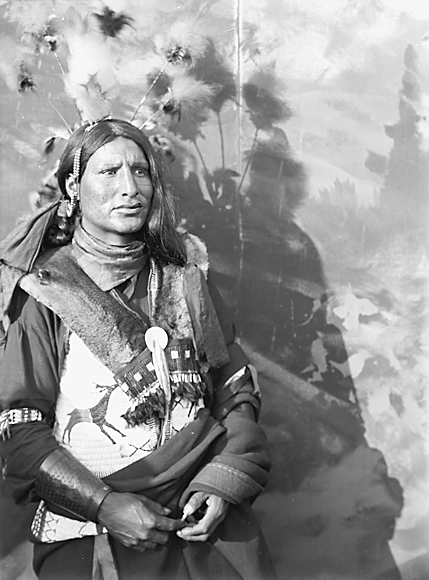 Henry Iron Shell, perhaps a grandson? More later… Dietmar |
|
|
|
Post by Dietmar on Nov 19, 2008 8:27:46 GMT -5
Some of Iron Shell´s sons are in this photograph: 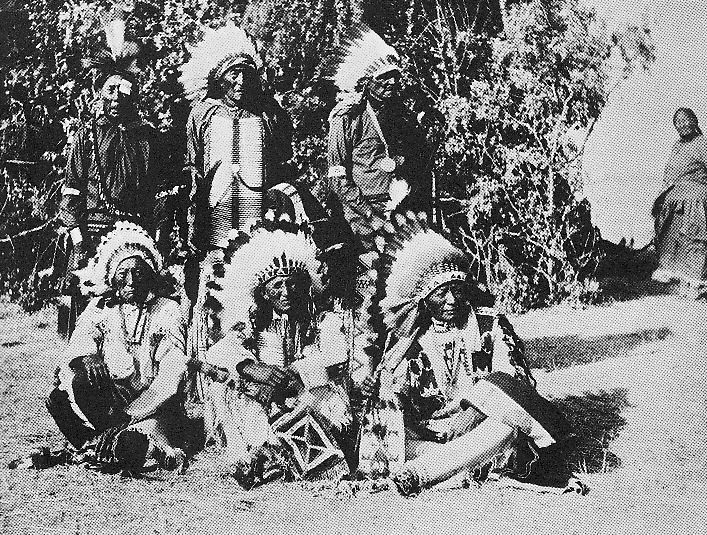 standing, left to right: Pete Iron Shell, Foolish Elk, Brave Birdsitting: Bear Dog, Joe Frightened, Search The Enemy (aka Arnold Iron Shell)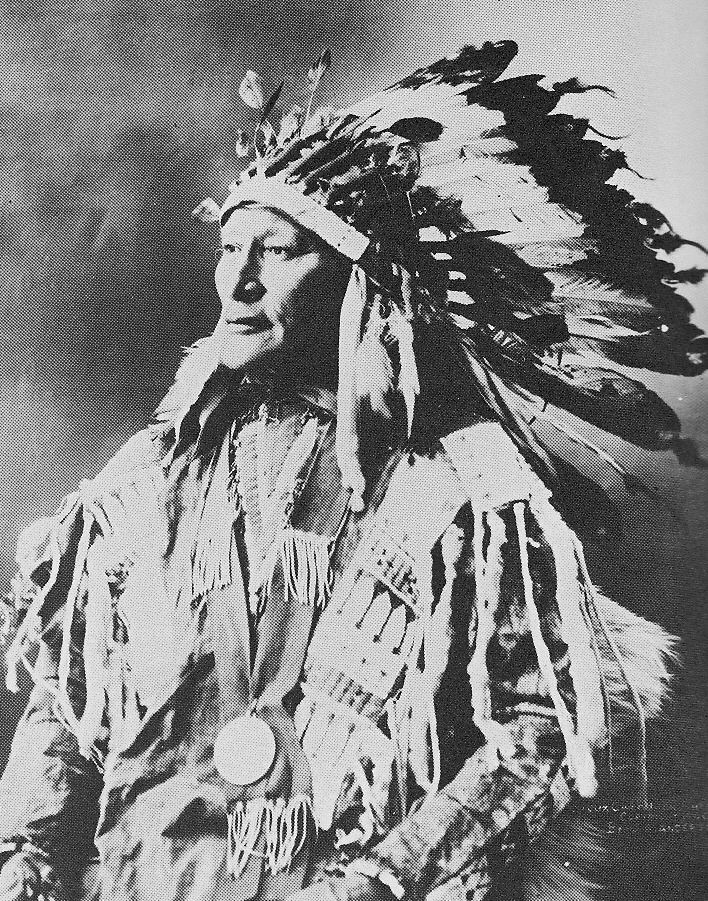 This is the well-known Anderson photo of Iron Shell. Is he the eldest son of Old Iron Shell? |
|
|
|
Post by kingsleybray on Nov 19, 2008 12:20:16 GMT -5
Interesting about the relative age of Young Iron Shell and Hollow Horn Bear. According to the Carl Iron Shell statement that I posted on the Center Woman thread (maybe we could pull it across into this thread?) these two were sons of Old Iron Shell by the same mother, yet the census data indicate they were both born in 1850 within a month or so of one another. The fact that one son got the father's name suggests he may indeed have been the eldest. James R. Walker has a discussion in one of the papers published by Ray DeMallie in LAKOTA SOCIETY about the concept of the birthright (unfortunately he doesn't give the Lakota term) by which the formal authority in an extended family was passed down to the eldest son of the person holding the birthright. However Walker says it could be transferred to another son or another person entirely. Could this have happened with Hollow Horn Bear? He certainly emerged as his father's main successor to tribal political status.
Something similar may have happened with Young Man Afraid of His Horse. He had a brother named Very Good, who some censuses (admittedly not all) indicate was a couple of years older than Young Man. Nevertheless Young Man was the son who inherited his father's status. Maybe the name Very Good is a clue - a too laid-back eldest son? Ok, just a fancy, but I think this concept of the birthright is important, and we may have another example of it with the Iron Shell sons. I shall try and post something later on the Iron Shell tiyoshpaye, the Orphan band.
Kingsley
|
|
|
|
Post by jinlian on Nov 19, 2008 12:55:22 GMT -5
Kingsley,
most probably you've already this information, but anyway: on the concept of "birthright" and authority being handed down to the eldest son, there's also a statement by Blue Horse in a letter to Elbridge A. Burbank:
"I am the second son of the great Sioux Chief, Smoke, to whom more than seventy-eight years ago, there was born two sons, viz, Big Mouth and Blue Horse. As Big Mouth was the elder, he became head chief upon the death of our father..."
|
|
|
|
Post by Dietmar on Nov 19, 2008 15:03:47 GMT -5
Kingsley, I have transfered two of your posts on Iron Shell from the "Center Woman" thread: Here is my information from Carl Iron Shell, via Rosemary Lessard (letter to KMB, April 18, 1983). Carl was the son of Peter Iron Shell, a grandson of old Iron Shell.
"There is a tradition in the Iron Shell family that 'Old' Iron Shell had twelve wives - not all at once - all of whom were related. We learned of three of these wives, who may have been the women to whom Iron Shell was married longest, or who may have been those who bore him children. Carl believed that Iron Shell married Roan Horse Woman first, then Center Woman, then Old Burnt; he believed that the last two were full sisters, but didn't know whether Roan Horse Woman was their sister or their cousin (parallel cousins are called 'sisters' in Lakota terminology. I am not certain how these three marriages overlapped.
"Incidentally, two other sisters of Center Woman and Old Burnt became the wives of American Horse, the Oglala chief.
"The children of 'Old' Iron Shell and Roan Horse:
'Young' Iron Shell
Shot at Many Times
Hollow Horn Bear (the eldest)
Bird Necklace
Goes to War
"The children of 'Old' Iron Shell and Center Woman:
Arnold (perhaps called 'Search the Enemy' in Lakota)
Blue Whirlwind (a daughter)
They Love Her (a daughter)
Pretty Bird
"The children of 'Old' Iron Shell and Old Burnt:
Peter
Holy Man
Bear Dog
Roan Horse (a daughter, named for her aunt)
Lightning (a daughter)"
Information provided by Arnold Iron Shell will be found throughout Royal B. Hassrick, THE SIOUX: LIFE AND CUSTOMS OF A WARRIOR SOCIETY (University of Oklahoma Press, 1964).
Not sure of the connection between what looks like two Center Womans, but anyway, important information, and - jinlian alert!! - a clue to the American Horse marriages too!
From the 1900 Rosebud Reservation census (accessible online at .
Old Burnt was then alive, born May 1838, lived in the family of her son Shoshone (born 1860) and his wife Lightning. The children of the latter couple: Thomas and Sophie Shoshone, born 1890 and 1893 respectively.
Old Iron Shell's sons in the 1900 census.
Hollow Horn Bear, aka Tons of Bone, born March 1850
Young Iron Shell, born April 1850
Goes to War, born April 1851
Stephen Brave Bird (aka Never Comes Down), born September 1857
Bear Dog, born September 1858
Arnold Iron Shell (aka Swimming Skunk), born January 1864
Peter Iron Shell, born December 1876 (nb may be a grandson)
According to the 1889 Rosebud Land Agreement signatories, Bird Necklace was born in 1864/65.
Toksha
Kingsley |
|
|
|
Post by kingsleybray on Nov 19, 2008 18:00:51 GMT -5
The origins of the Iron Shell family among the Miniconjou were expressed by Arnold Iron Shell (born 1864) in his 1940s interviews with Royal B. Hassrick, published in the latter's ethnography THE SIOUX: LIFE AND CUSTOMS OF A WARRIOR SOCIETY, chapter 1. On p. 8 Hassrick introduces Iron Shell's winter count (start year 1807) and states it was begun by Iron Shell's "great-grandfather, [and] recorded events first among the Miniconjous, later among the Brules where his father [old Iron Shell] resided." On p. 9 the count names some of these antecedents: "[Arnold] Iron Shell's grandfather, a headman among the Miniconjous, died in 1816, the winter 'Shot in the Heel Died.' The next year reports the death of Bone Bracelet, Shot in the Heel's father, the first keeper of the count."
p. 28 - The investiture of Iron Shell and three other Brule leaders as Wichasha Yatapika (Honoured Men or Supreme Owners) in about 1850 is described in detail. Iron Shell was "the son of Shot in the Heel, headman among the Miniconjous, [and] he was the leader of the No Mother Band."
Bone Bracelet is I think the man described in a contemporary journal and named Crooked Hand, a "Saunie" (Saone) leader, who met Manuel Lisa in 1812.
Many northern Teton people (Miniconjous, Sans Arcs, Hunkpapas) joined the Brule tribal circle in the early 19th century. One story told by Archie Fire was keyed to winter count traditions, and indicated that after the smallpox epidemic of 1818 which killed many Brule old men, the Brules appealed to the Miniconjou to help them with their ceremonies. With their families many joined the Brules. My research in the documentary record suggest that there was a steady flow of such families who joined the more southerly Brules and Oglalas who enjoyed advantages in both the fur trade and the intertribal horse trade.
According to Lakota academic and historian Victor Douville these northern incomers were identified as the Ashke (a lock of hair) people. This is recognized today as the name of the Iron Shell tiyoshpaye. From the mid-19th century Iron Shell's band is usually known in contemporary documents as the Orphans (Wablenicha) or the No Mother band (Hunku-wanicha). George Hyde, that great historian of the Lakota, I think got this story wrong when he explained the origin of the name as being a battle in 1844 in which the leader Male Crow and most of his warriors were killed by Crows and Shoshones. The families of the dead warriors were called the Orphans. The fight certainly occurred but pertains to the Oglala Orphan tiyoshpaye, whose community at Pine Ridge is the modern town of Wounded Knee.
A story in the Makula (Breast, or Left Heron) winter counts (part of the Josephine Waggoner papers in the Museum of the Fur Trade) states that the 1849 cholera epidemic struck disproportionately hard two bands: the Oglala Shkokpa band (see Ephriam's profile of Yellow Bear) and the Brule Orphans. It maybe that this tragedy was the origin of the term Orphan for the Iron Shell band. My work on population history suggested that up to 500 Brules, equivalent to about 70 tipis, may have died in the 1849-50 epidemics. If we consider how sizeable the Bull Tail-Iron Shell village is indicated to be in journals from the 1840s - up to 200 lodges in June 1849 on the very eve of the epidemic - and then contrast with the post-epidemic size of the Orphans - rated at 50 lodges in 1867, just over 300 people - then we can see how severe the blow may have been.
Iron Shell was born in 1815 (the Year the Sans Arcs built an earth lodge) according to Susan Bettelyoun. He is first mentioned in the documentary record in 1843 as a young war chief in Bull Tail's band, who had distinguished himself that summer in the war with the Pawnees. Indeed I have very recently heard an oral tradition which states that in this same year it was Iron Shell himself who re-captured one of the Cheyenne Sacred Arrows from the Skidi Pawnees. In the trading season of 1844-45 Ft Platte trader David Adams mentions Iron Shell as chief of a band. He married Roan Horse Woman in the 1840s, and their son Shot at Many Times died as a boy (maybe in the 1849 cholera? - see above). Iron Shell then underwent the Ghost owning ceremony. In summer 1850 he was one of the four Brules chosen by a pan-Teton council as wichasha yatapika.
Victor Douville (conversation with KMB, May 11, 2001) stated that "part of the Orphans derived from the [Brule] Kiyuksa" band. This perhaps means a cohort (males or females) marrying in. Also the Orphans and the Wazhazhas (Conquering Bear's band) were "always together", so it is believed they are sister bands budded from a parent group. Indeed the Ashke according to Victor were originally derived from some Wazhazhas (a band formed from Lakotas marrying Poncas) who joined the Northern Tetons at some point late in the 1700s. Then a generation or two later many Ashke families shifted back into the Brule circle - as I described above. In a later conversation (June 18, 2001) Victor stated that Iron Shell held the "primary leadership" of the Orphans and "part of the Wazhazha". Sounds rather like the birthright concept we were talking about earlier today.
The Orphans (like the Wazhazhas) usually hunted north of the North Platte, rarely hunting in the Buffalo South (Republican River hunting grounds of the Southern Brules and Oglalas). By the 1860s because of the contraction of the buffalo herds they frequently ran with the Northern Oglalas and Miniconjous in the Powder River Country. I think that Iron Shell was bitterly jealous of Spotted Tail's elevation in 1866 to Upper Brule principal chief. But the failure of the buffalo compelled Iron Shell to bring in the Orphans to the Whetstone Agency about 1869. Although as far as I can tell he afterward remained at the agency, many young men of the Orphans seasonally visited the non-treaty Lakotas in the north.
I like Iron Shell and it's nice to be able to put this down in this thread with all these great pictures
Kingsley
|
|
|
|
Post by Dietmar on Nov 24, 2008 12:10:46 GMT -5
 Goes To War by Jesse Hastings Bratley, 1898 (SIRIS)  Goes To War & his brother Hollow Horn Bear by Frank Rinehart, 1898 (Denver Public Library)  Goes To War by Octave Chanute, 1898 (Denver Public Library) |
|
|
|
Post by charlie on Nov 25, 2008 4:50:25 GMT -5
I have these names for Iron Shell: PAKESKA MAZA and MAZA PANGESKA.
Which is more correct?
SHELL is agreed as "CARTRIDGE" or "CLAM" ? Which is the correct translation? Thanks.
|
|
|
|
Post by Dietmar on Nov 25, 2008 9:49:31 GMT -5
Here´s another John Anderson photo of Iron Shell: 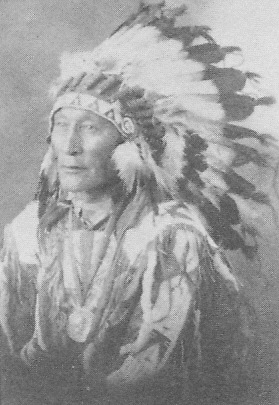 |
|
|
|
Post by kingsleybray on Nov 25, 2008 14:24:53 GMT -5
charlie, the correct form is Pankeska Maza, because in Lakota the adjective comes after the noun. Pankeska is a large round marine shell of the type used to fashion gorgets and other ornaments - Pankeska Wakpa, Shell River was the Lakota name for the North Platte because that was where old-time intertribal trade fairs were held where such things were exchanged. I've sometimes wondered whether an 'iron shell' could be a medal, of the type given out to prominent native leaders by colonial agents, traders, etc. But that's only a guess - and not even one I'm very confident in
A clam shell would be tuki, a gun cartridge is mazasu - literally an 'iron seed'.
hope this helps
Kingsley
|
|
|
|
Post by miyelo on Nov 25, 2008 22:38:06 GMT -5
aho everybody!
sorry i have not been here for awhile but I see much good info has been posted! great photos!! i will print these and show them to Iron Shell relatives here.
Kingsley...Victor is a wealth of information isn't he?? what a good man. He and I are hopefully going to be doing some projects soon together. I want to film his Lakota Star Knowlege presentation. It is incredible.
the LIttle Thunders are having a family meeting this coming weekend so hopefully I will make it back from Porcupine in time to attend. I will ask them about alot of this stuff. I do know that ''Roan Horse'' was really ''Rode Horse'' to the Lakota.
in sad news, in case anyone here knows Duane Hollow Horn Bear, his only son passed away last week from a seizure. Very sad.
|
|
|
|
Post by jinlian on Nov 26, 2008 1:24:51 GMT -5
in sad news, in case anyone here knows Duane Hollow Horn Bear, his only son passed away last week from a seizure. Very sad. Sorry to hear that - professor Hollow Horn Bear has come here in Italy more than once and sounds really a fine person. My condolences to him and his family. |
|
|
|
Post by charlie on Nov 26, 2008 6:08:44 GMT -5
Hi Kingsley. In Italy, many authors translate his name as CARTUCCIA (Cartridge) DI (of) FERRO (Iron) perhaps because, in nature, don't exsit "Shell" makes with iron's material. Anyway, if the word PANKESKA meaning "Shell" i prefer labelled him as CONCHIGLIA (Shell) DI FERRO. Many thanks.
|
|
|
|
Post by kingsleybray on Dec 15, 2008 16:54:43 GMT -5
The Hollow Horn Bear and Iron Shell capsule biographies in the Josephine Waggoner papers at the Museum of the Fur Trade state that:
Hollow Horn Bear [approx. 5 years old] was one of the prisoners taken by the troops at the Blue Water fight 1855.
Iron Shell had three wives, of whom the youngest was captured at the Blue Water and taken east by a soldier. In the 1849 cholera Iron Shell's band suffered most, only a few escaped.
Kingsley
|
|
|
|
Post by Diane Merkel on Dec 28, 2008 15:11:04 GMT -5
|
|